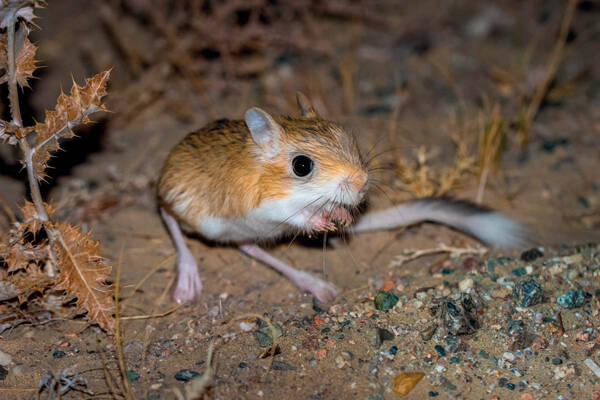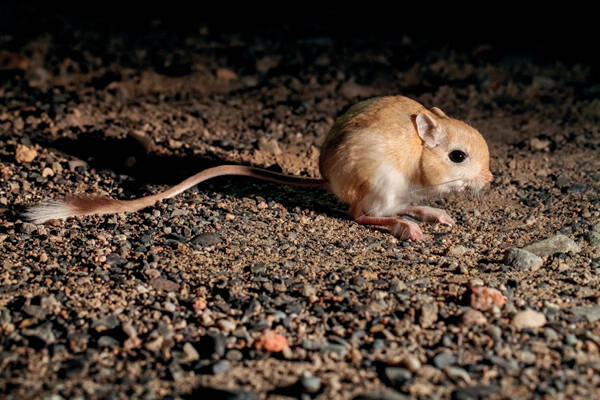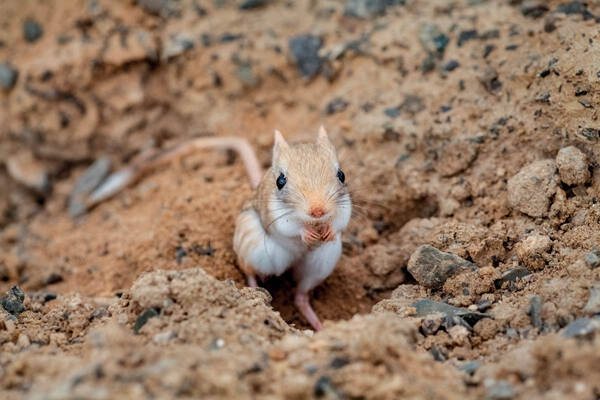Dipus sagitta
IUCN
LCBasic Information
Scientific classification
- name:Dipus sagitta
- Scientific Name:Dipus sagitta,Northern Three-toed Jerboa,Hairy-footed jerboa, gerbil, jumping rabbit, Yelaben (Mongolian)
- Outline:Rodents
- Family:Rodentia Jerboa T.Jerboa
Vital signs
- length:115-150mm
- Weight:
- lifetime:
Feature
It is of medium size, with a big head, big eyes, short ears, brown-gray fur on the back and pure white fur on the belly.
Distribution and Habitat
In China, it is distributed in Xinjiang, Inner Mongolia, Shaanxi, Jilin, and Liaoning. Abroad, it is distributed in Iran and the Caucasus region of Russia.
The habitat is diverse in terms of altitude, topography, and vegetation, but it is all sandy.
Appearance
The individual is medium-sized, with a body length of 115-150mm and an average of about 120mm. The tail is of medium length, about 1.5 times the body length, with an average of about 160mm. The ears are small, with an average length of about 18mm. The hind feet are three times the length of the front feet, with an average length of about 57mm. The hind feet have three toes, and the toes on both sides of the hind feet are completely degenerate. There are long and dense bristles on the soles of the feet, which are shaped like a "brush". They are good at jumping. The fur color on the back of the body varies, and it is slightly different in different seasons. It can be brown, gray-brown, or gray-yellow. The ventral surface is pure white from the chin to the base of the tail. The tail is brown-yellow, the tail end is hairy, and it is swollen like a brush. The tip of the tail is white, and the rest of the swollen part is black. The overall color becomes lighter in winter, and the h
Details
The three-toed jerboa belongs to the subfamily Dipodinae. This species is widely distributed in China, adapted to deserts, arid and semi-desert areas, with a large population, and is a common jerboa in my country.
The three-toed jerboa is a sand-loving species. Although its habitat is diverse in terms of altitude, topography, and vegetation, it is all sandy. In sandy alluvial fans, river beaches, fixed or semi-fixed sand dunes, and aeolian dunes in gravel deserts, it often chooses shrub deserts dominated by Haloxylon ammodendron and Calligonum, red willow dunes, poplar sparse forest dunes, and sand-dwelling vegetation dominated by Artemisia ordosica and Salix psammophila as its habitat.

The three-toed jerboa is active at night and hides in the cave during the day, covering the cave entrance with fine sand. It leaves the cave in the evening to forage for food, and only returns to the cave or digs a new cave when the sky is just getting light. The three-toed jerboa only uses its hind legs to jump and leap vertically, with a maximum vertical distance of more than 3m. The tail can not only control direction and maintain balance, but also tap the ground vertically to increase jumping power. General wind and drizzle do not hinder the activities of the three-toed jerboa, but when the wind speed is too high or it is cloudy and rainy, the activities will be reduced or even stopped. Once the wind stops and the rain stops, jerboas tend to come out of their holes earlier and become more active. The activity intensity of three-toed jerboas varies with the season. After coming out of hibernation in April, due to lack of food, the activity intensity is very low. As the weather warms up and plants sprout and grow, the activity of jerboas gradually increases. In mid-May, the activity intensity reaches the highest peak of the year due to reproduction. The activity gradually weakens in July and August. In late August, they begin to prepare for hibernation, forming the second peak of activity throughout the year. Generally, they enter the hibernation period from September to October. There is a certain order of hibernation. The first to hibernate are the elderly male individuals, followed by the adult female individuals, and finally the juveniles. The time of coming out of hibernation is not consistent in different places, and generally they come out of hibernation in March and April.
The three-toed jumping mouse is diffusely distributed, and the cave system structure is relatively simple, generally consisting of a cave entrance, a cave passage, a nest, a blind cave and a dark window. Each cave system has only one cave entrance, and the length of the cave passage varies, usually 1.5-2m, but the cave passage on the sand ridge is longer, with a diameter of 7.5-9.5cm. The nest chamber is located at the end of the cave passage, in a round shape, about 60-70cm from the ground, and the shallow one is within 30cm. The nest is round and made of soft weeds, with a diameter of about 13-15cm. The blind cave is located on both sides of the nest. The dark window is a preparatory passage dug from the tunnel or nest chamber to the surface, with only a thin layer of sand blocking the end. When the entrance of the cave is disturbed, the three-toed jerboa will suddenly break through the hole and escape from the dark window. The entrance of the cave is often buried by thrown sand, but the thrown sand does not gather into a pile.

The three-toed jerboa feeds on the stems, fruits and roots of plants, and also eats some insects. It does not need special drinking water, and the water in the plants is enough for its metabolic needs.
Three-toed jerboas mate soon after emerging from hibernation. The breeding season is from April to June, with a gestation period of 25-30 days, 2-7 litters, and an average of 3-4 litters. Usually they reproduce once a year, and very few can produce two litters. The young mice can reach sexual maturity in the second year, but those born later will reach sexual maturity after two winters.
Three-toed jerboas steal seeds and seedlings of sand-fixing plants such as Artemisia ordosica and Caragana korshinskii in grasslands, seriously damaging vegetation in sandy land and undermining sand-fixing afforestation. In agricultural areas, they gnaw on crop seedlings and dig out melons.

In 2004, a survey in China showed that the population size and age structure of the three-toed jumping mouse varied greatly with the seasons. The peak period was from September to October, with a large proportion of young mice, accounting for about 36.7%. The lowest number was in June and July, with a population density of less than 30% of that in September and October. Among them, adults and elderly individuals were dominant, and subadults (young individuals of the previous year) accounted for only 13.8% of the population. The proportion of females is slightly higher than that of males, about 54.3%.








